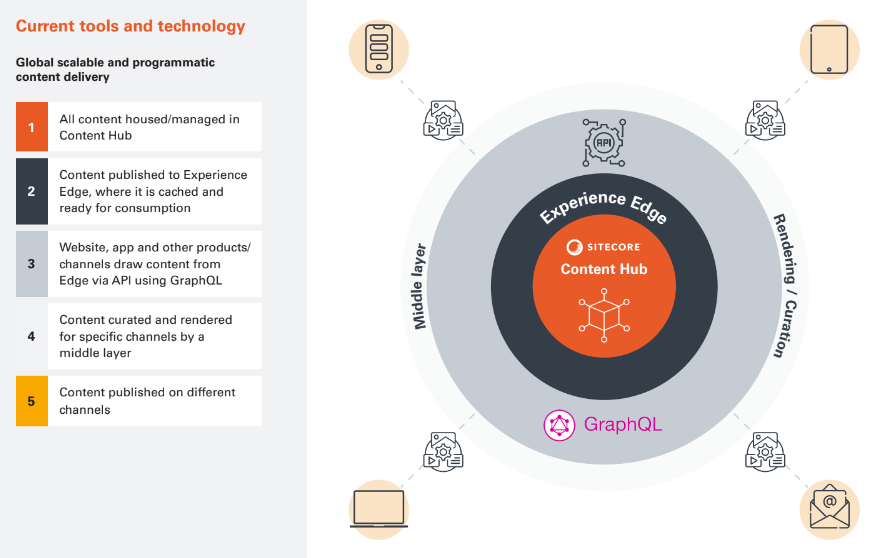You know that omnichannel delivery is a must-have to compete today. But can your marketing team keep up with these demands? A 2021 Forrester Study commissioned by Sitecore found that 73% of marketers use traditional web CMS for channel-specific content, with 43% creating content for just one channel.
A headless approach to content management reshapes how teams distribute digital content by decoupling content authoring and storage from the display and delivery platforms to offer the flexibility and scalability needed when distributing omnichannel content.
Separating content creation from the presentation layer provides much-needed flexibility and scalability for omnichannel distribution. A headless CMS enables today’s organisations to dynamically deliver content across websites, apps, e-commerce platforms, and other digital mediums supporting customer experiences.
It’s important to note that a headless CMS approach is not always the right solution for every business. I primarily see this benefiting businesses with complex websites, content and data feeds that require an alternative to the rigidity of traditional Web CMS platforms.
1. Improve flexibility
A headless CMS offers flexibility by decoupling back-end content management from the front-end presentation layer. Unlike traditional CMS platforms that bind developers to specific templates and presentation constraints, a headless CMS separates the content delivery and display rendering process. Developers no longer need to grapple with the limitations of a CMS in deciding how content appears on different channels.
For content strategists and marketers, the agility of a headless CMS streamlines content deployment across platforms. This efficiency enables quick updates and content iteration, facilitating timely audience engagement.
2. Stop duplicating content distribution efforts
A headless CMS supports streamlined content operations using APIs to display content created in an omnichannel content platform (OCP) and published in your Content Delivery Network (CDN). This approach eliminates the need to re-author content on different platforms manually. The API-driven method simplifies content updates, allowing teams to focus on content consistency rather than technical deployment.
Consider a scenario where your company needs to update a specific piece of content published on the website in different areas or languages, e-commerce or booking sites, apps and knowledge bases. Traditionally, this might require updating content in multiple places within the Web CMS, the e-commerce platform, the app platform, CRM and service management system. This all takes a lot of manual effort and coordination that could produce errors and delay this important update across all channels.
When you use a headless CMS, your team only has to author content once in an OCP like Sitecore Content Hub and publish the approved content to Experience Edge (the CDN layer). The headless engines – whether they be for the web, app or e-commerce platforms – then access content in the CDN via APIs. This capability is particularly beneficial for organisations delivering a lot of personalised content. Without a headless architecture, achieving this level of personalisation and efficiency in content distribution would be significantly more challenging.

3. Enhance user experiences and customer engagement
Traditional personalisation methods involved organisations tagging content for specific personas, using cookies to identify visitors, and presenting tailored content based on the information. However, this approach has limitations, mainly because it's confined to a Web CMS and does not extend to apps or other platforms. This does not suit organisations striving to offer a consistent, personalised experience across multiple digital touchpoints.
Instead, your organisation can adopt an integrated approach by using a Customer Data Platform (CDP), an OCP and headless delivery layer to personalise content at the outset. First-party data stored in the CDP informs content delivery. Content is then managed separately at the OCP and tagged for personalisation, with the headless CMS programmed to query this content and display it according to the predetermined rules.
A headless CMS displays the relevant information to each visitor based on their first-party data, including past searches, preferences and localisations. This setup allows for a level of personalisation previously unattainable, as two visitors to the same site can now see different content tailored to their specific profiles.

4. Content distribution across multiple channels
The headless CMS architecture supports an omnichannel strategy by enabling seamless content distribution to websites, mobile apps, and beyond without channel-specific changes. This flexibility is particularly relevant in today's multi-device environment; according to an Adobe study, Australians use an average of 2.18 devices simultaneously.
A headless CMS also allows quick content updates in response to customer feedback and market changes. Such agility boosts brand reliability and customer engagement as audiences receive timely content through their preferred channels.
Displaying content via a headless architecture means content remains consistent, supporting a cohesive brand identity and customer experience across your digital channels. Without this consistency, building a strong brand presence becomes harder, and customer engagement could suffer.
5. Reduce costs
Running a headless CMS is significantly cheaper than maintaining a full authoring website, which incurs high costs due to processing each request and rendering pages for each website visitor. Headless CMS reduces processing needs by delivering content based on the current query rather than pre-rendering the site.
A headless CMS also offers environmental benefits by reducing server load and optimising data usage. Less processing power means a smaller carbon footprint for your organisation.

Conclusion
A headless CMS coupled with an OCP offers a dynamic approach to content distribution by offering flexibility, efficiency, and personalisation. It enables your organisation to streamline operations, reduce costs, and enhance user engagement across multiple digital channels.
At Creative Folks, we believe that taking a headless architecture approach to your website, apps, e-commerce and other business systems and using an OCP to author and manage the content can deliver great benefits. Whilst they might not be right for every organisation, they better suit organisations that require consistent, dynamically updated and personalised content across many channels. They also support teams weighed down by operational inefficiencies and delays caused by content teams waiting for developers to implement those changes.
Your organisation should consider specific needs, technical capabilities, and strategic goals to determine if the benefits align with your operational model and content strategy. Evaluating its suitability based on your organisation's unique requirements will ensure you get the most from its capabilities, positioning your brand to thrive in an increasingly digital and content-driven landscape.
Creative Folks can enhance your content delivery strategy
Does your marketing team need to move beyond a traditional CMS? We have over two decades of experience transforming content delivery processes. We have implemented successful omnichannel content platforms for customers such as Jetstar Airways, The Australian Ballet, UWA and the Department of Industry, Science and Resources.
We do more than simply deploy one-size-fits-all solutions. Our experts collaborate with you to understand your content management needs and reduce the manual work completed by your marketing and content teams. Please visit our Sitecore Content Hub page for more information.
Related blogs
What elements define omnichannel content management?
From chaos to clarity: How to define your content production process
How content orchestration supports an omnichannel retail strategy




 Previous
Previous


